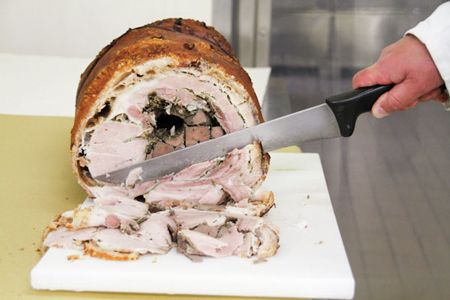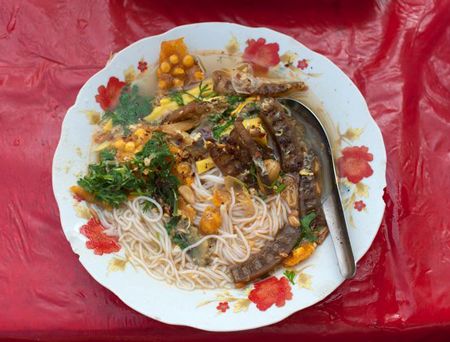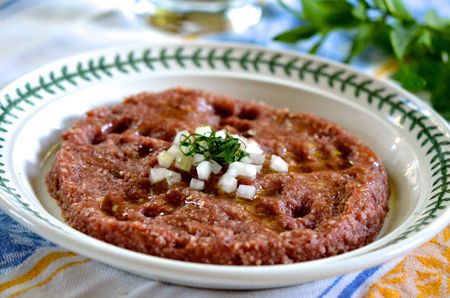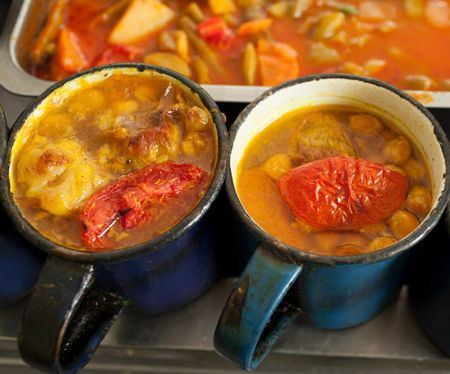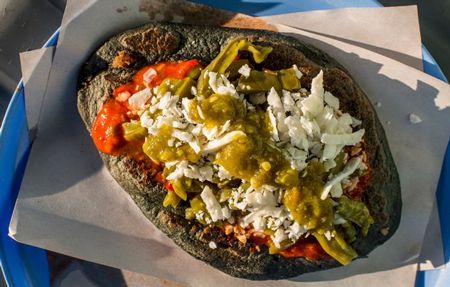Porchetta di Bevagna among the five typical dishes of the world to taste
From Myanmar to Mexico City passing through Bevagna
The New York Times
To accompany our cover article on regional food specialties around France, we asked some food experts to weigh in with their tips for must-eats in other parts of the world. Following is a selection.
Porchetta in Umbria, Italy
In the ancient town of Bevagna in central Umbria, down a narrow and winding street, is a magnificent butcher shop called Macelleria Tagliavento. Head through the modest and dimly lit space, perfumed by cured meats hanging overhead, and you will find a delicatessen case filled with yet more meat. Past that, perched on a ledge, is a particularly magnificent porchetta. I grew up mostly around central Italy, and this version is the type I remember loving before industrialized methods took over.
Porchetta — a deconstructed whole pig, gutted and spiced, then stuffed, tied and roasted, with layers of meat, fat, stuffing and skin — originated in the area around Rome and in the former Vatican states. These days, it’s available all over Italy, including in Bevagna, in the heart of one of the most famous pork-curing regions of Italy. At Macelleria Tagliavento, the skin, glazed and crispy, covers perfectly moist flesh; traditional organ meats, wild fennel pollen, garlic, rosemary and lots of salt and pepper hide inside. The head is left attached for extra-dramatic presentation. It’s usually sold out by noon.
Marco Biagetti and Rosita Cariani, the owners, cut the porchetta by hand and use thick slices from a great round loaf of artisanal bread. After wrapping the sandwich in a little butcher paper, they will send you on your way into the street, blinking in the bright light.
SARA JENKINS, the chef at Porsena and Porchetta in New York.
Mohinga in Myanmar
Tender rice noodles in a slightly pungent yet delicate fish broth, dotted with chunks of green banana stem, may not be everyone’s idea of breakfast food, but mohinga, a classic morning-time food in central and southern Myanmar, is a great way to start the day. It comes in many versions. In Yangon, formerly Rangoon, the broth is made aromatic with lemon grass, ginger and garlic. On the west coast, in Rakhine State, it’s topped with flaked cooked fish and a dollop of chile paste.
Mohinga is sold by streetside vendors and in some teashops. Pick a place already busy with locals. The vendor will put a tangle of rice noodles in your bowl, pour over the hot broth, add a sprinkle of cilantro, a section of hard-cooked egg, some minced scallion greens and perhaps some slices of fish cake. You can then choose one or more deep-fried toppings.
In Yangon you’ll find busy mohinga stands along downtown Maha Bandoola Road, and along small side streets. My favorite is called Ou Yi, in a tree-lined yard by a side lane off Inya Road. The mohinga costs more than the usual streetside fare — the equivalent of $2.50 rather than $1. This is shocking to locals, but for travelers it’s the best kind of bargain: the broth has a wonderful balance and freshness that is deeply satisfying. Ou Yi is open at 5:30 every morning. Get there before 9 a.m. — they tend to run out early.
Far from Yangon, there is outstanding mohinga at the main market in Nyaung Shwe, near beautiful Inle Lake — but only every five days; “market day” rotates around the region. Head up the main aisle of the market building; just before you reach the end, you’ll see to your right a huge wok full of tomato-tinged mohinga broth. Pull up a stool and tuck in. There’s a layered perfume to the fish broth, a delicate blend of lemon grass, shallots, tomato acidity and something more (perhaps a secret local herb?) that sings on the tongue. You’ll be back for more.
Naomi Duguid, the author of “Burma: Rivers of Flavor.”
Kibbe Nayyeh in Antelias, Lebanon
Kibbe, a subtly spiced mixture of minced lamb and bulgur wheat, can be found around the Levant, cooked in myriad ways. It can also be served raw, as kibbe nayyeh (nayyeh means raw in Arabic), often called the national dish of Lebanon. It’s sometimes referred to as Arab steak tartare, although it is smoother and spicier — the meat is moistened with olive oil instead of egg yolk, and should ideally be pounded in a marble mortar with a heavy wooden pestle until it turns into a silky paste. I can still picture my Lebanese mother and grandmother sitting on low stools on either side of a beautiful large mortar taking turns to pound the lean chunks of lamb with a big wooden pestle.
As you can imagine, this took quite some time and hardly anyone these days makes kibbe nayyeh by hand, least of all restaurants. But some, like Al-Halabi, a timeless restaurant in Antelias, a northern suburb of Beirut, manage to achieve the same smooth texture despite mincing the meat in a grinder. Its kibbe nayyeh is one of the best in town: as silky as the one I remember from my youth, with the same lovely pale pink color, a sure sign it is mixed just before it is served, with a little iced water added to keep the color and loosen the meat. Al-Halabi also uses a minimal amount of bulgur wheat, which allows for a meatier texture. And the seasoning is subtle, with enough spices to enhance the flavor of the lamb but not overwhelm it.
ANISSA HELOU, the author of “Levant.”
Piti in Kars, Turkey
In Kars, a northeastern Turkish province where dairy and cattle ranching dominate, one local specialty stands out for its unlikely main ingredient: lamb. Piti, a stew of chickpeas, mutton and tomato in a broth flavored with sheep tail fat and sarikok, or dried turmeric, embodies the region’s past as a Silk Road way station and, for four decades around the turn of the 20th century, a Russian territory. The dish originated in Azerbaijan, though piti there is sometimes flavored with saffron instead of turmeric. Tomato, a novelty in Turkey’s remoter provinces until well into the 20th century, is probably a recent addition.
Piti is baked in small single-serving vessels — metal cups in Kars and clay dishes in Azerbaijan — and is served with broth strained from the meat and chickpeas. In Kars it is poured over torn strips of lavash mounded in a shallow bowl. Absorbing the liquid, the bread becomes a dumpling-like cloud redolent of meat juices, with a slight musty-bitter edge from the turmeric. Some diners make it a one-dish meal by placing meat and chickpeas on top of the lavash and mashing the legumes into the bread, while others eat the two side by side. Though the hearty dish is served year-round it’s especially suited to Kars’s notoriously long and harsh winters.
Kristal Lokantasi is one of the last restaurants in the drowsy provincial capital (also called Kars) to serve piti. Tahsin Kaya, the owner, said that his version, available for lunch only, is prepared using the same recipe as when his father opened the establishment, in a storefront down the street, over 50 years earlier. It sells out daily, even in summer, when temperatures can hit the 80s.
ROBYN ECKHARDT, writer and blogger, EatingAsia.
Tlacoyos in Mexico City
People have been eating tlacoyos — masa patties stuffed with either refried beans, a salty, spreadable cheese called requesón, or mashed fava beans — in one form or another since pre-Hispanic times, and they are still sold at sidewalk stands across Mexico City. Female vendors hand-pat the corn dough into the shape of a flattened football and then cook the patties until crisp and freckled on both sides, often at charcoal grills that sit inches from their laps. The toppings, though, push tlacoyos into the upper echelon of Mexico street food: cooked cactus strips, fresh onion and cilantro and a spoonful of salsa.
My favorite stand is run by Rosa Peña Sotres, who typically wears her gray hair in a braid. To find her, you get off at Metro Salto del Agua and head north on bustling Calle López. Her stand sits near Calle Delicias, just before the carnitas stand with the big clay pots. Ms. Peña Sotres has made tlacoyos for decades (her mother made them before her) and her skill comes across in each bite. The blue corn masa, which she prepares herself, is fluffy and airy; the fava beans add moisture and a nutty sweetness. When she asks, “Con todo?” the answer for me is always yes.
I loved her tlacoyos so much that I asked her if she accepted students. Soon afterward I found myself in the spotless patio of her house, in a nearby town. She showed me how she grinds her beans on a ground stonetool called a metate — brushing the stone cylinder against the base with sharp, quick motions — and the correct way to place the tlacoyos on the grill, first in the center, then off to the edges. After making a few dozen tlacoyos, my feet and back hurt. Ms. Peña Sotres had barely broken a sweat.
LESLEY TELLEZ, writer and blogger, The Mija Chronicles.





